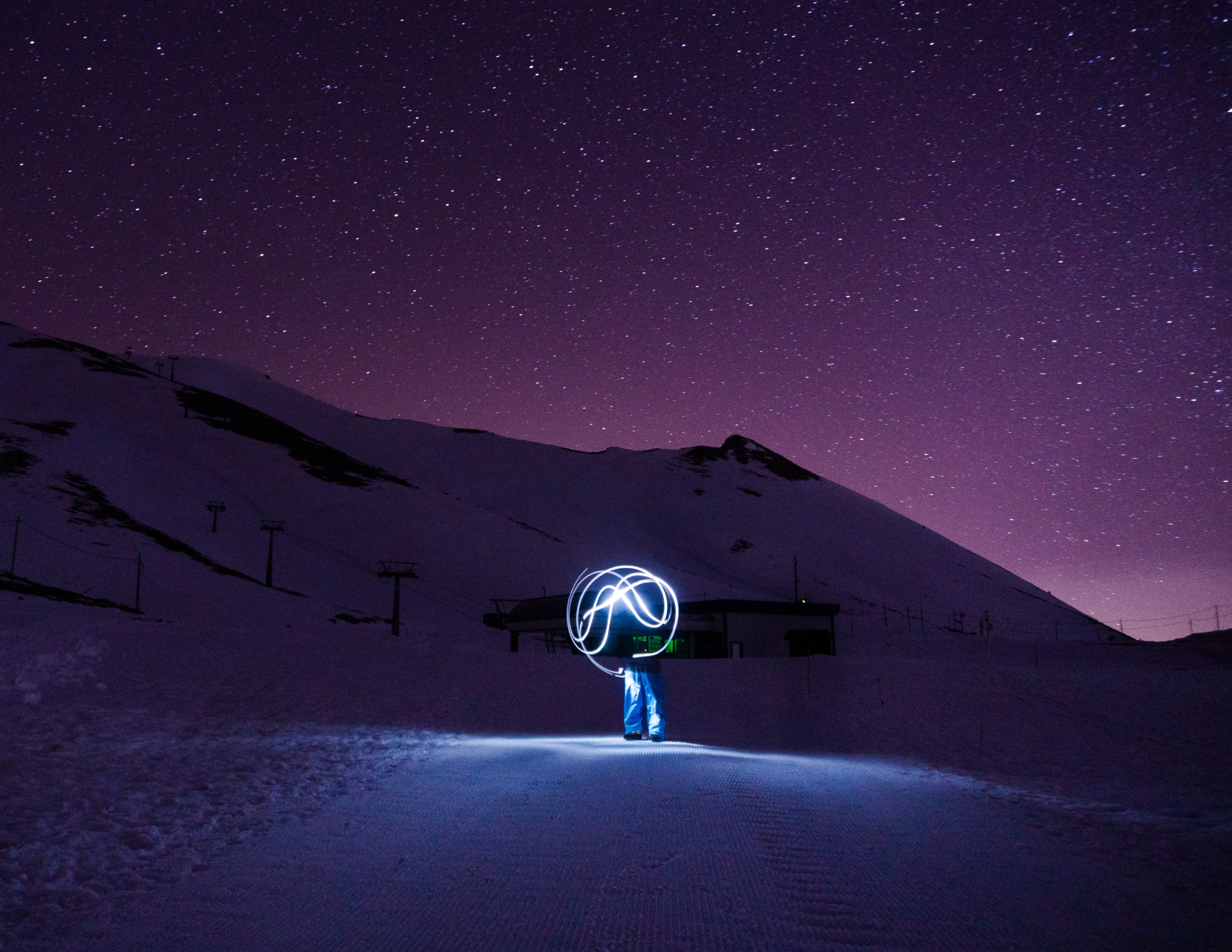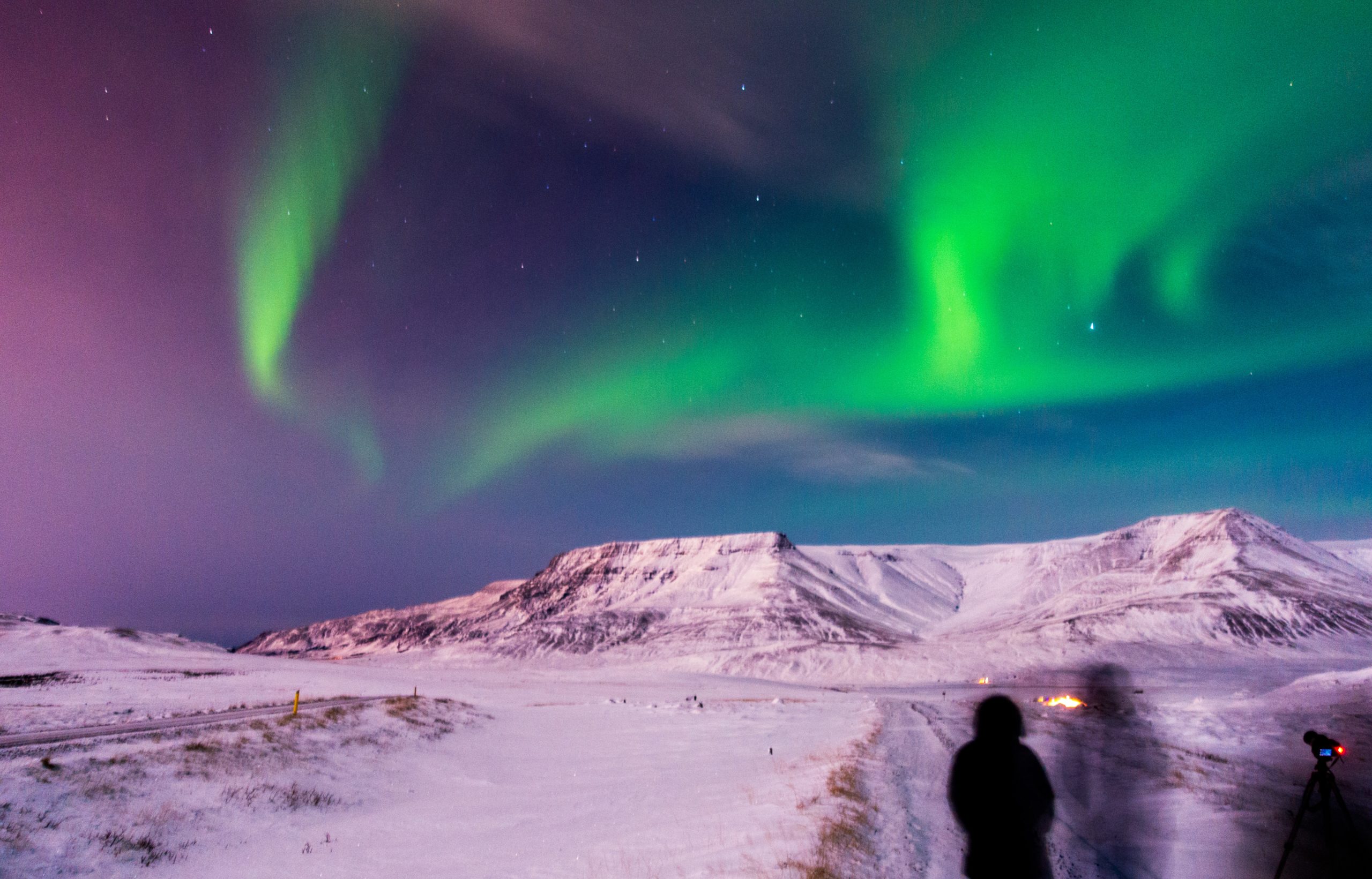Northern Lights Painting...and 5 other fun things to do when the lights aren’t out
We spend a lot of time looking for auroras, but what do we do when we can’t find one? Fellow hunters, meet northern lights painting.
Northern lights painting may not be the first thing you think of when you pack your bags for a hunt. (And it might mean something different to different people! Don’t worry, we’ll come back later for the crafters.)
But if we’ve learned anything at all from years of chasing the aurora, it’s how to be prepared for any and all kinds of nights. Whether there’s a show to see, or not.
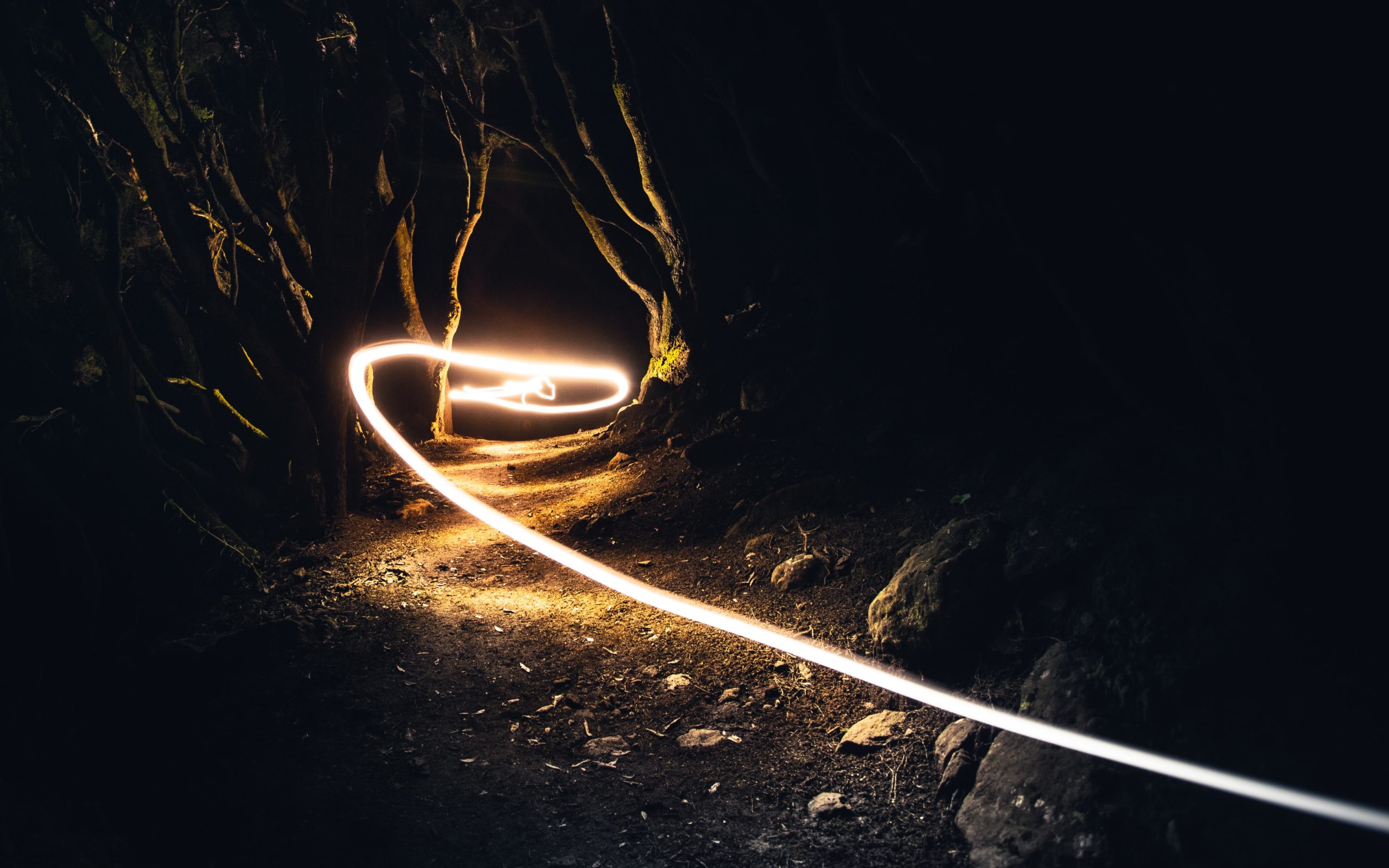
1. Light painting, or, Northern Lights Painting
Known as “Light Painting” or “experimental long exposure photography”, this is the ultimate activity when you’re waiting on the lights to show up. It may not be auroras, but it’s a fan favorite for a dark night with no show.
Popular in its own right, light painting or, northern lights painting, as we like to call it, is an activity that requires a camera. All you need to do this is a DSLR camera or a camera that can accommodate a long shutter setting, a tripod or flat surface, and a light.
This is an experimental process for a reason, and there is no wrong way to do your own northern lights painting. (Well, as long as you’ve got the flat surface and the long shutter. If your camera is moving you’ll have a hard time capturing an image, and if you can’t access a longer shutter, it will be harder to create these effects.)
That being said, this is an activity for people of all levels of artistic skill. The photos you make will look differently depending on where you are, what settings you try, and what tools you use to create light.
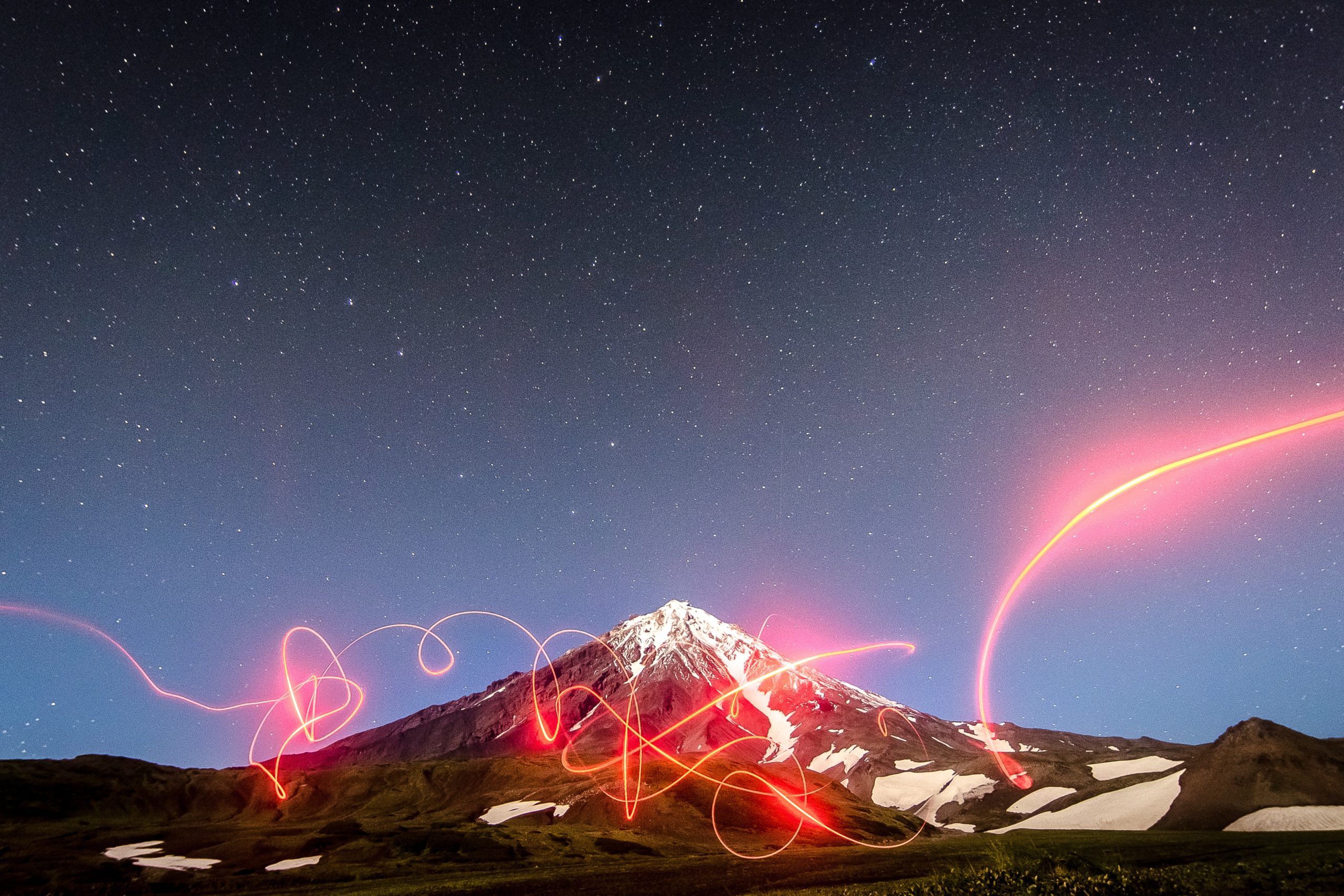
You can even do this inside! (Though, we find ourselves doing this outside most of the time, since we’re always waiting on the aurora to show up.)
Once you’ve got your tripod and your camera set up, you’ll be using a lot of the same settings you’d use for a northern lights shot. This means low aperture, and typically a higher ISO than you’d use for a daylight photo.
(Depending on the effect you’re going for, this could be an ISO as low as 400, and as high as 3600- but don’t take our word for it! This is art, so you’ll have to try different combinations out to see what look works best for you.)
And the key of course, is the extended shutter. Most cameras can accommodate up to 30 seconds of shutter, which is plenty for time for you to create a compelling shape or image. If you find that this is too bright, remember the golden rule of northern lights painting, and adjust till you get the look you want.
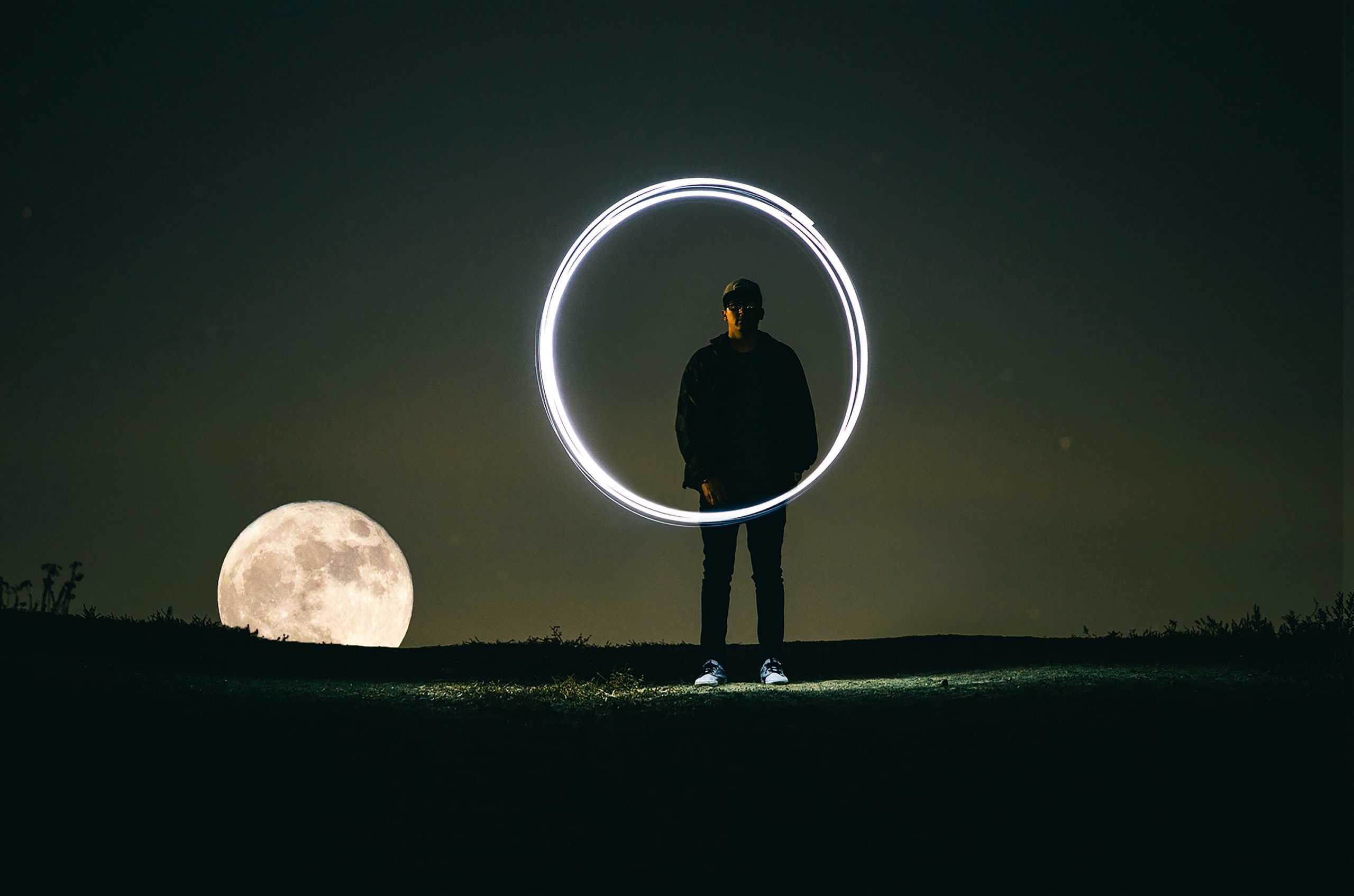
These photos are created by manipulating lit items in the camera’s field of vision. This means you can use fairy lights, mobile phones, torches, sparklers, LED tools, and so on. You can write messages, create three-dimensional patterns, draw shapes- the opportunities are endless. You can make your own aurora! (It is northern lights painting, after all..)
This is a great activity whether or not the lights are out, and we suggest checking out the work of other light painters. There are a lot of opinions on the best types of light, how to diffuse light with tracing paper, and how to color white light with plastics.
There are also countless tutorials on how to make the tools themselves, in order to achieve certain looks. (We are big fans of the long piece of wood with fairy lights taped to it.) If you choose to go the sparkler route, be careful!
Activities like this can spark dry grasses and create wildfires. Make sure you are operating in a damp area, and practicing fire safety while you work. No photo is worth an accidental blaze.
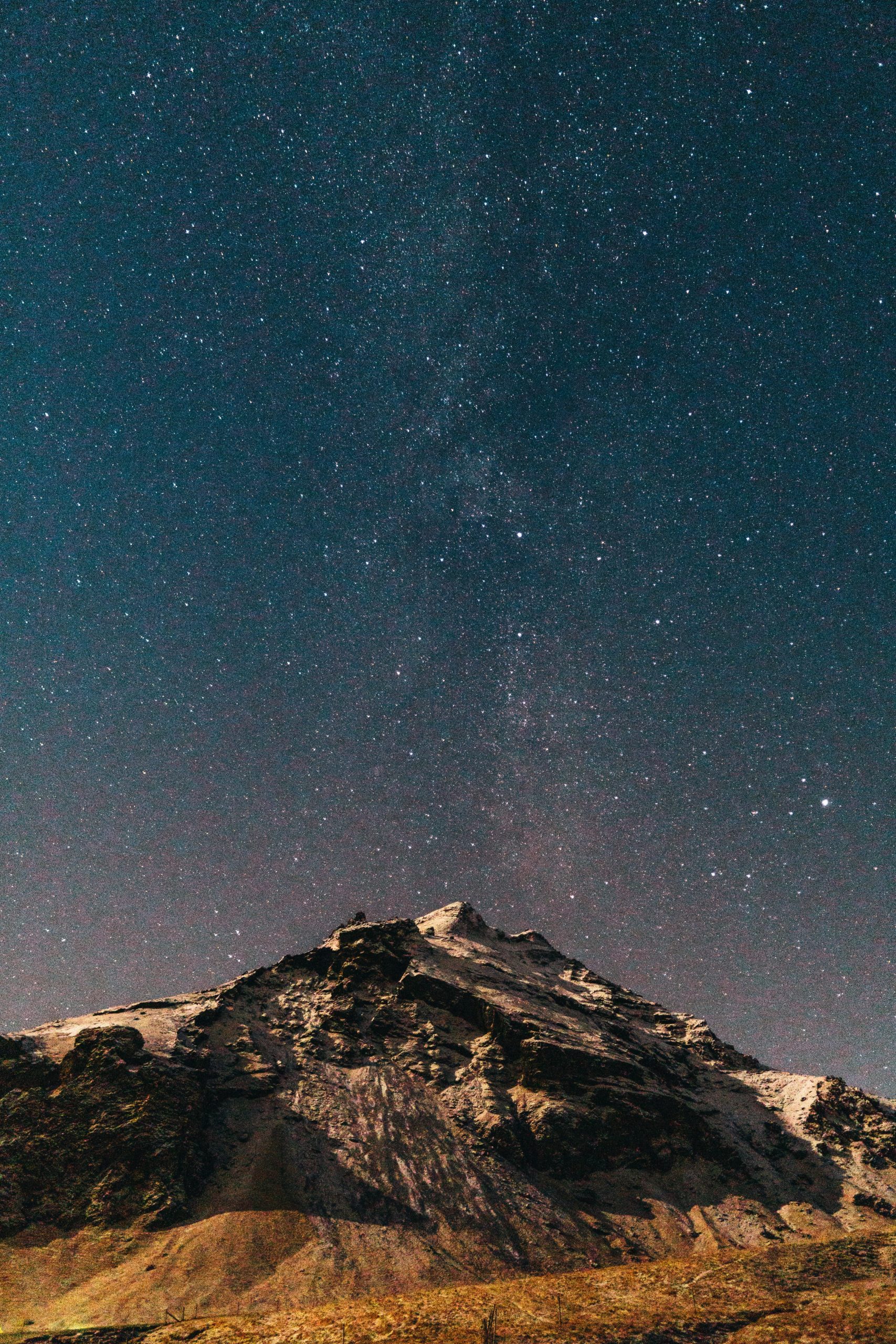
2. Stargazing and Telescoping out the heavens
Northern lights painting gives us something to do down here on Earth, but what about when we’re back to eyeing the skies?
That’s when it’s time to stargaze. While this activity does require the same clear skies as auroras, it doesn’t necessarily require any special equipment. (But don’t worry gadget collectors- there definitely is some.)
With a little knowledge and a lot of darkness, you can find constellations, planets, nebulas, and all sorts of celestial bodies. One can follow satellites, shooting stars, and even an eclipse or two in the Icelandic sky. (And you ought to make the best of it while you can, because we miss out on nearly ever summer event!)
However, if you want to elevate your stargazing experience, there are a lot of tools that can help you do this. Telescopes, binoculars, star maps, and more apps than you can imagine exist just for this very purpose.
Stargazing is a burgeoning hobby with an incredible community, and depending on where you are- there is likely a whole contingent of fellow gazers that you can learn from and watch with.
There also happens to be a lot to learn, so this hobby may stay with you far beyond an Icelandic holiday. Amateur space weather enthusiasts all over the world are even helping contribute to modern science.
In fact- it was stargazers that helped us understand STEVE. But, it’s a wide world out there. What far off planets or mysteries of the verse are YOU going to discover?
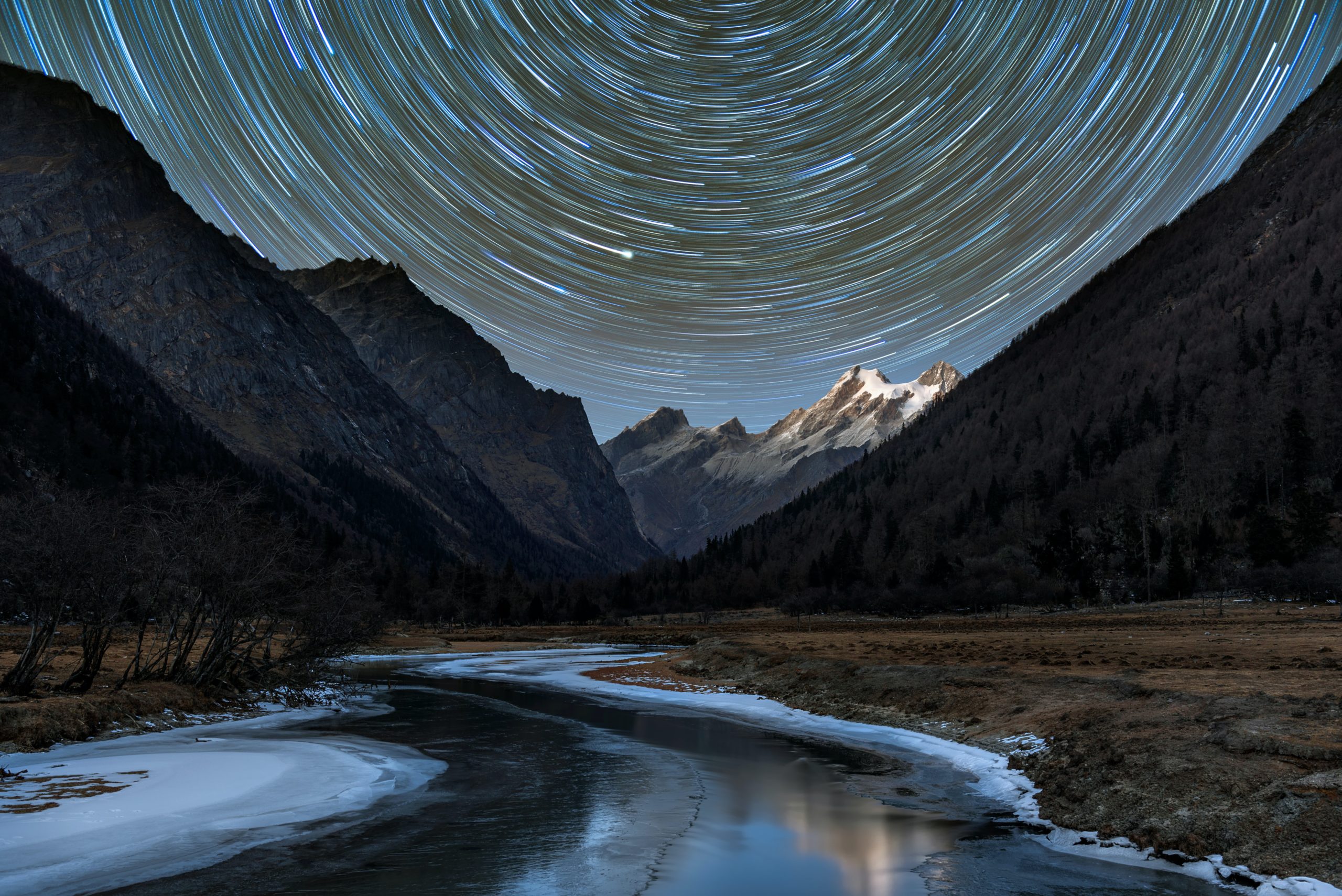
3. Astrophotography, Star Trails and Galaxy Hunts
While stargazing and northern lights painting can both become camera-centric activities, this is definitely one. Many aurora hunters end up becoming photographers out of necessity- because it is just too hard to chase such an ethereal thing and not keep a piece of it for yourself.
Photos are one of the many pieces of the magic, and they are not easily come by. Their rarity and the work that goes into making them is in some ways just as rewarding as the aurora hunt itself.
(Not to mention, a well-timed photo can be a great early detection tool in actually finding the northern lights on a dim evening.)
As many of you know, a great photo is the ultimate souvenir. It’s hard for a t-shirt or a fridge magnet to beat that kind of memento. But what do you do when there’s no aurora to capture?
That’s when we widen our scope even more, to astrophotography. Astrophotography is a big term that includes aurora photos- and about a thousand other things. The reality is that we can access so much more of the sky than we realize.
With the naked eye and our usual context in light polluted places, there’s a lot that we don’t see. But with a great lens (be it in a camera, telescope, or slick pair of binoculars,) suddenly the far rings of Saturn, or the super up close topography of the moon, become easily viewable.
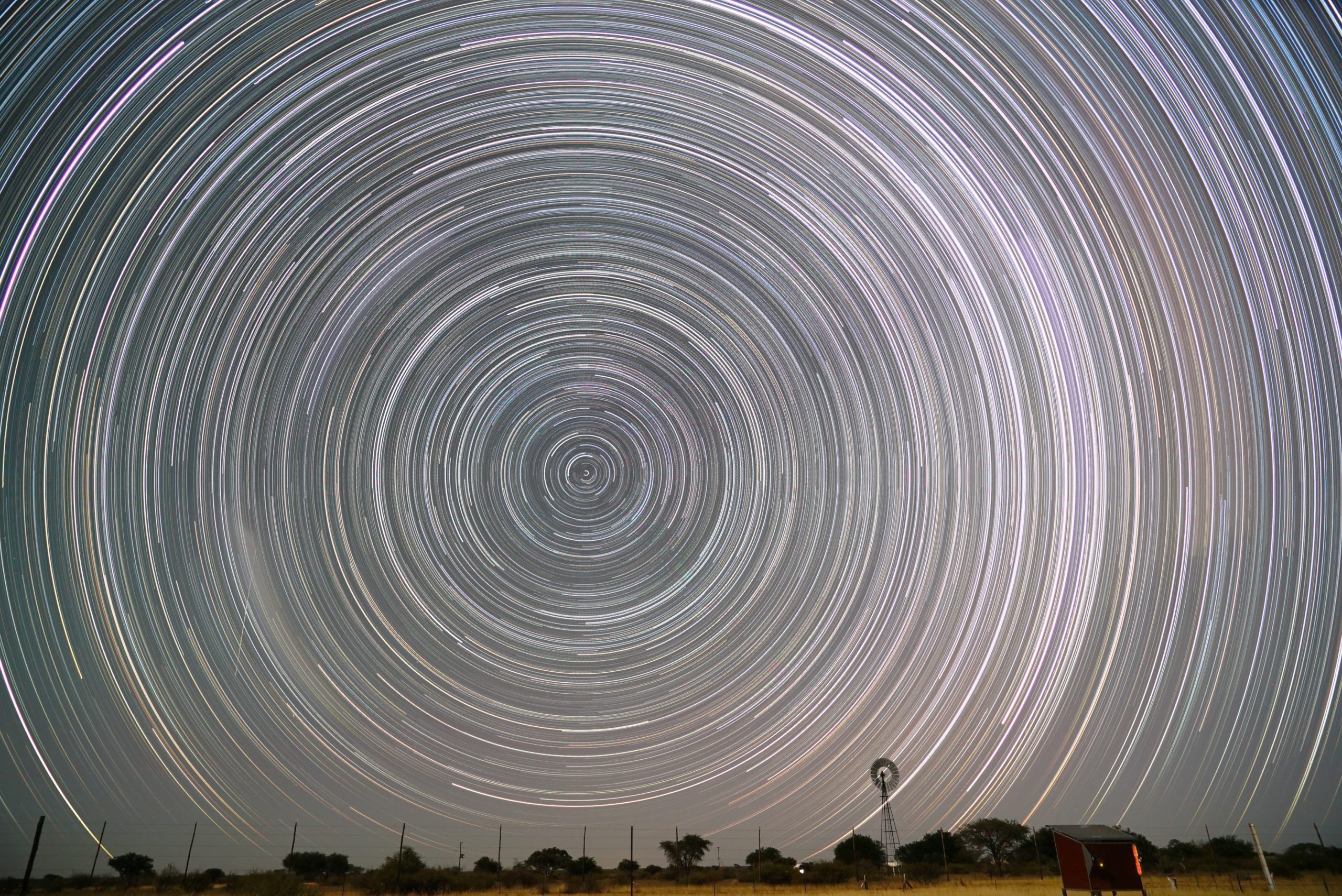
Star Trail images
So after you’ve done your northern lights painting of course, turn your lens to the stars. If you’ve got your tripod and plenty of battery, you can create star trail images by setting your focus to infinity and using the longest exposure you’ve got available to you.
This can be a tricky situation, because you may need to set your camera to the bulb setting, or acquire a cable release for your specific camera model to allow these unusual levels of exposure. (We are talking about 15-30 minute long exposures here!)
But, thanks to aids like Startrails, you can also take shorter exposure images, and the program will layer them together for you. This process makes this type of photography a bit more accessible to the novice astrophotographer, and it cuts down on image noise as well.
This is a special branch of nighttime photography, so have a look around if you’re interested! There is a whole world of star trail enthusiasts, and a million tried and true practices for getting the kind of images you want.
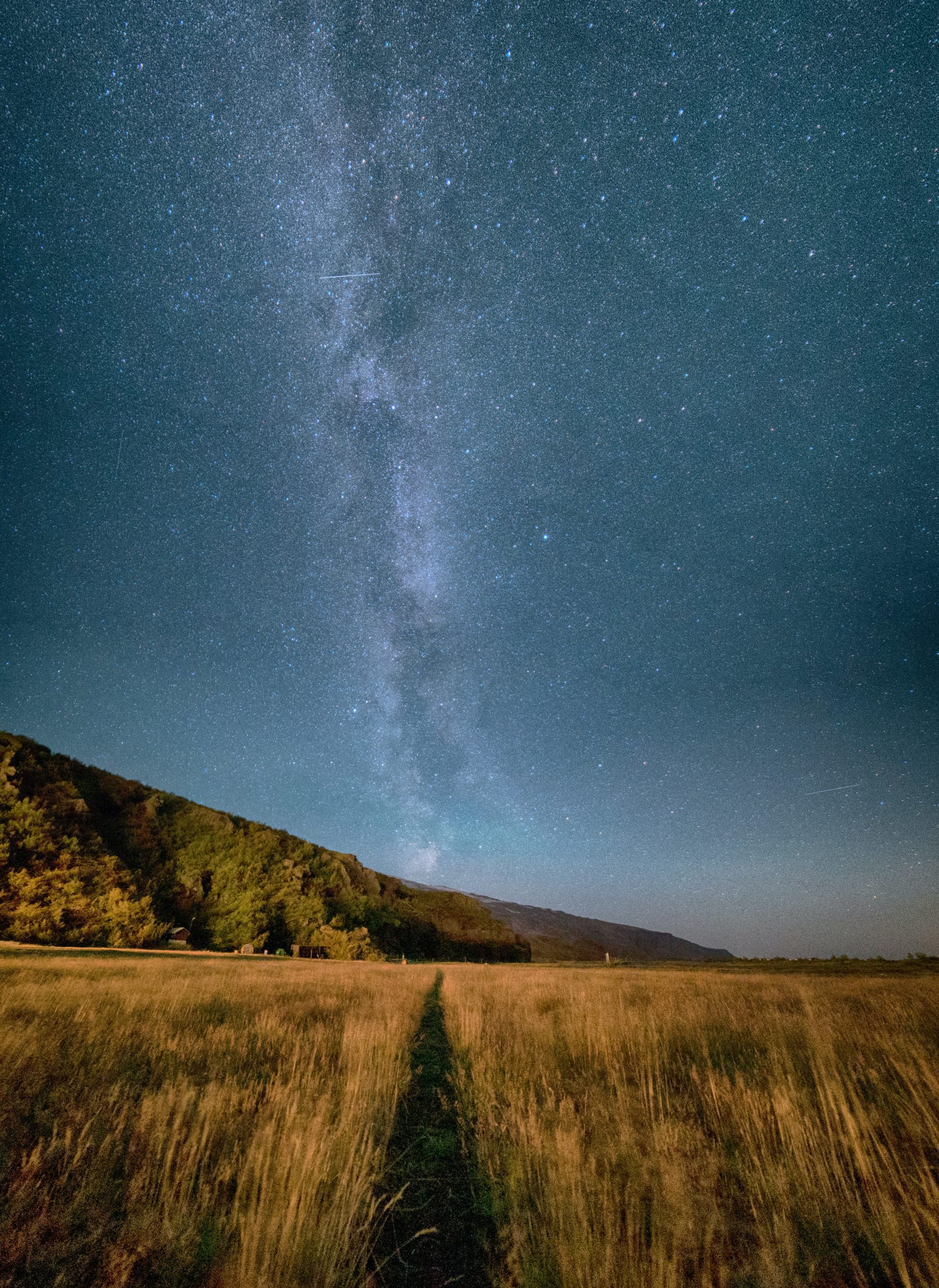
Galaxy Photos
If you’re looking to capture nebulas and far off bodies of celestial light, you may need some specialized gear. Many of these photos are taken with professional attachments and some are even captured through telescope attachments!
If you’ve got a telescope with you and want to venture into that realm of photography, go forth and please send us a copy! We’d love to see it. But for those of you who are trying to capture a galaxy with your DSLR, you may be in luck.
It’s not the easiest, but it is possible. You’ll need a lot of the same stuff you’d bring with you for northern lights photos, so make sure you’ve loaded up your manual capable camera, a sturdy tripod, a fast lens and some patience.
A new item that you’ll need is a starmap app. An interactive map can help you locate the milky way for that evening, which will cut out a lot of the guess work. Above all, you need to be in a dark place. Just like aurora hunting and northern lights painting, light pollution drowns out the good stuff.
Just like the star trail photos, you’ll be working with a pretty long shutter. As you try this out, don’t be disappointed if your photos don’t look quite as outrageous as some of the galaxy shots you’ve seen.
Many photographers in this field are utilizing specialized gear, processes like time blends and startracking, and doing a lot of heavy lifting in a post processing software like Photoshop.
These images are sometimes the product of a great composite job, or a lot of really skillful editing in a RAW image. You can certainly capture a viable shot with your regular aurora gear, but if you’re interested in this- don’t despair! All of these tricks can be learned, and there is ample information on the web to help you. Everybody has to start somewhere.
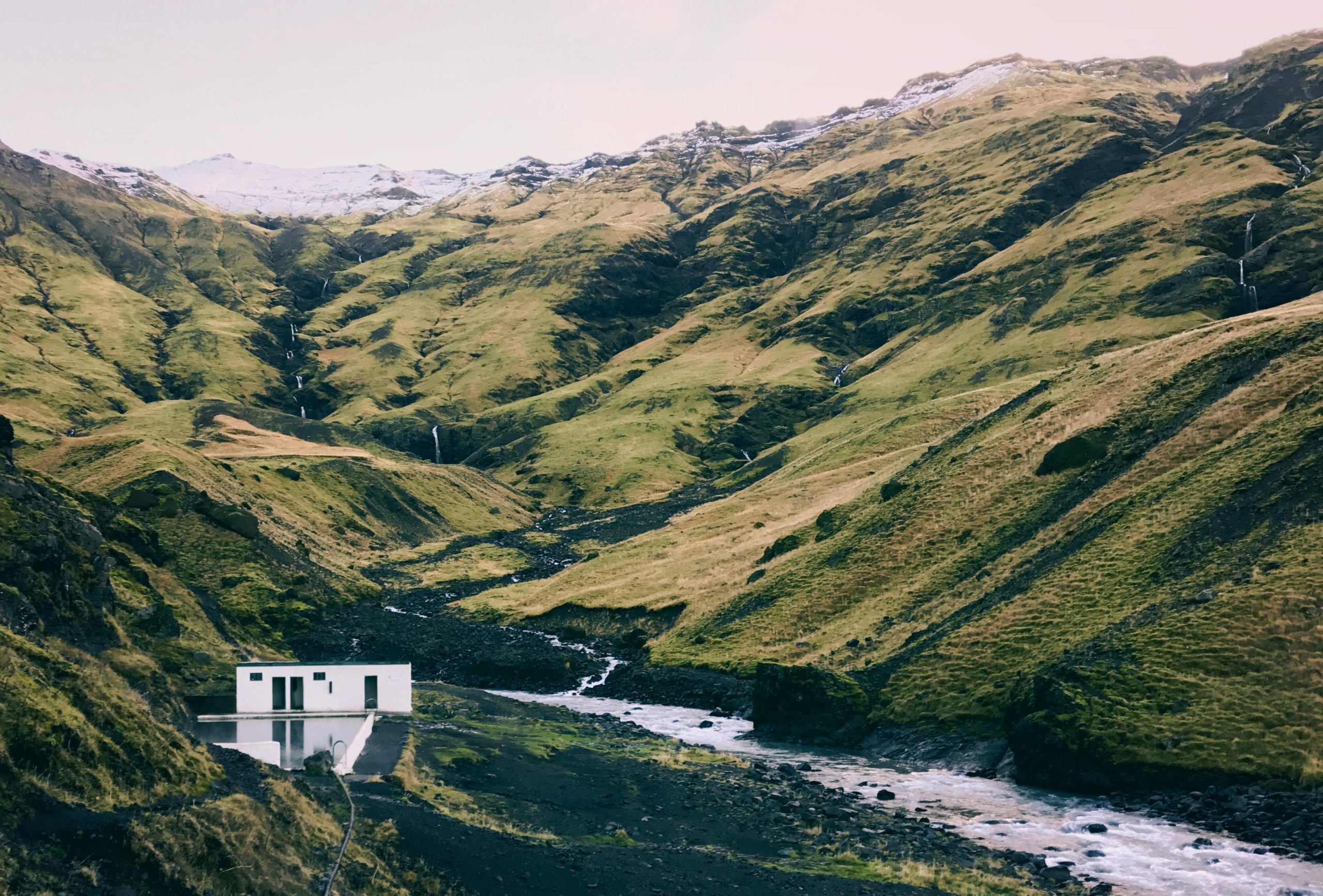
4. Hot spring night soaks
Now here’s an activity that you don’t need a camera for. (Unless you want to make some friends extra jealous.) Half of the time, we’re doing this instead of setting up the cameras- and sometimes the lights come out anyways!
The best seat in the house is always in the hot pot. Iceland’s geothermal landscape is a treasure chest of natural hot springs and great places to soak. But despite that, Icelanders have installed geothermally heated swimming pools in nearly every town, and hot tubs at many summer houses.
If there’s a pool to sit in, we can almost promise it’s heated. (Unless it’s an ice pool, that’s a thing.) If you’re staying in town, there’s a swimming pool near you that is accessible for a low price year round, and if you’re extra lucky, you may have a hot pot in your vicinity.
If you’re a hiker, you can venture forth into a natural hot spring like Reykjadalur, or even Landmannalaugar. If you choose these wilder options, remember to be careful.
Hiking in the colder aurora season and in the darkness is a next level activity, and should only be taken on by aurora hunters that are confident in their trekking skills. Make sure to tell a friend where you’re headed, and bring the appropriate gear.
And check the weather! Some of these natural springs are in mountainous places that experience quickly changing weather and limited visibility, so it’s good to understand the area before you set out.
But if you make it.. Enjoy! There’s nothing in the world like laying in a wild hot spring at night watching nature make its own northern lights painting, just for you.

5. Lay back and pop some Bubbly
As we near the more.. Luxurious end of our list, it feels only right to mention the northern lights igloo option. If the lights are out, this is an incredible option. If they aren’t out, it’s an incredible option. If you’re here in the summer, it’s an incredible option. You can’t go wrong with this activity.
The Bubble Hotel of Iceland consists of a handful of fully transparent domed igloos that are tucked away in the embrace of two lush forests. This means you’ve got two location choices, and all the nature you can handle.
These hideaways are sequestered in their own groves, heated, and outfitted with their own luxury sleeping accommodations. To catch the lights, we often wait outside for long periods of time in the wind, weather, and low temperatures.
But imagine if you could do it wrapped in a down comforter with gourmet treats, in bed? Because of their rural locations, you’ll have all the darkness you need for optimal aurora watching or stargazing.
If you catch the lights out here, there’s no better seat. But if you don’t- you still get to walk away with a night spent in the height of luxury, surrounded by the grandeur of raw Icelandic nature on all sides.
It’s certainly the furthest away you can get from roughing it, while still being right in the middle of the woods. So excuse us while we slip into something a bit more.. Comfortable.
The best place to see Northern Lights in Iceland: 10 of the most magical spots for aurora watching and stargazing
No matter how many times we’ve seen the aurora, we’re always looking for the best place to see northern lights in Iceland.
We never stop looking for the best place to see northern lights in Iceland. From the far reaches of the west, to the lush forests of the east- it is impossible to count them all. Iceland may be a small island, but the hidden treasures here are many. Where was the best place you watched the sky from?
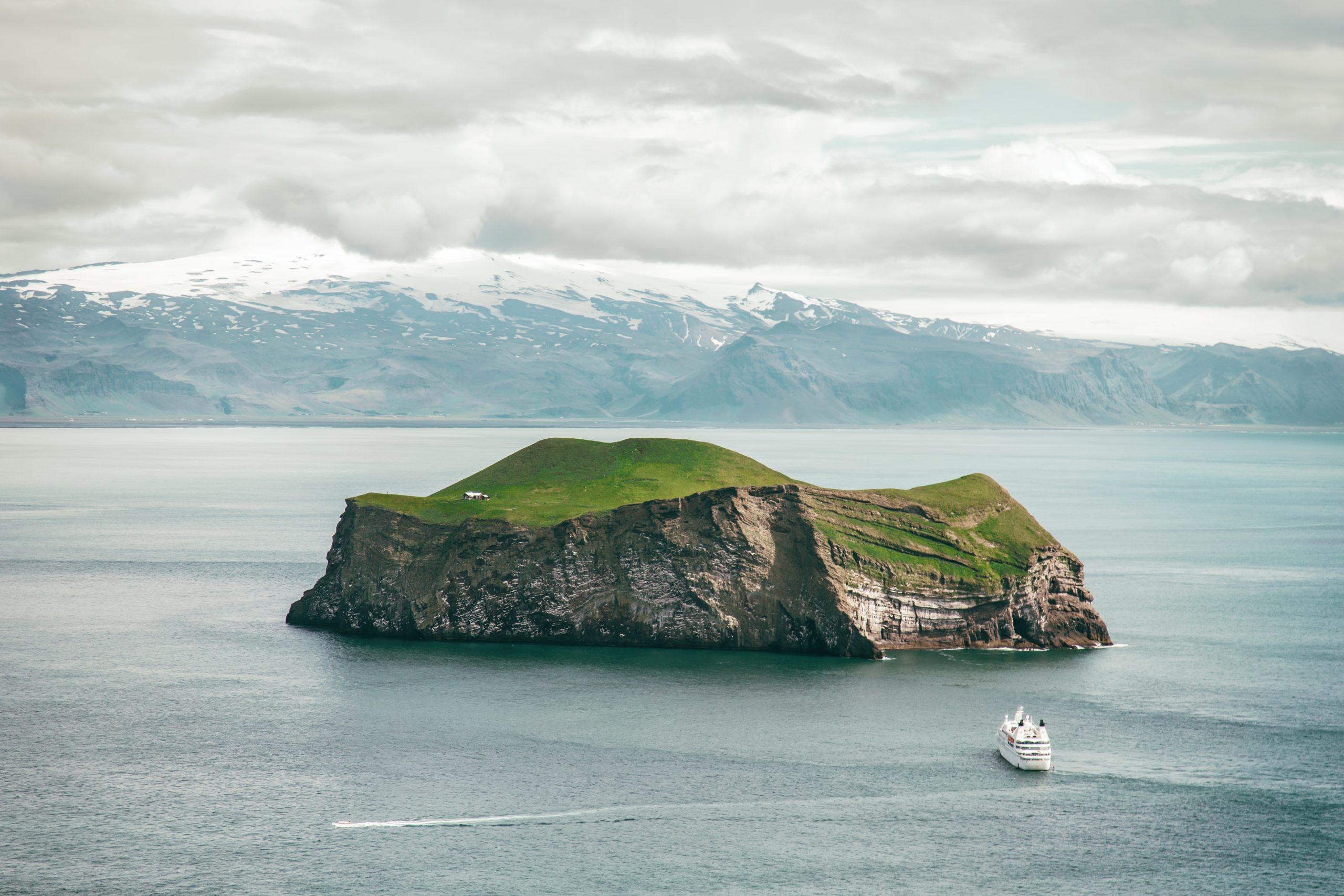
1. Vestmannaeyjar
Vestmannaeyjar, or The Westman Islands, lie right off of Iceland’s south coast. Accessible by ferry or plane, they are an often overlooked gem and in our opinion, a best place to see northern lights in Iceland.
The Westman Islands are a self-contained world all to themselves, and boast some of the warmest annual temperatures in the entire country! Benefitting from the gulf stream, they are known as a wildlife-rich area that enjoys plentiful fishing, whale and birdwatching, and music festivals and sport in the summer.
A visit to the Westman Isles is punctuated by incredible sights. Lighthouses on rock stacks, one of the most famous volcanic eruptions in modern history, vast sea caves, and a whole chain of gorgeous, uninhabited islands. And being far south, one of the last places to catch the lights at the end of the auroral season.
Many great country aurora spots are remote, but here in Vestmannaeyjar you’ve got everything you can think of within a few kilometers. Including some of Iceland’s most notable golfing and dining!
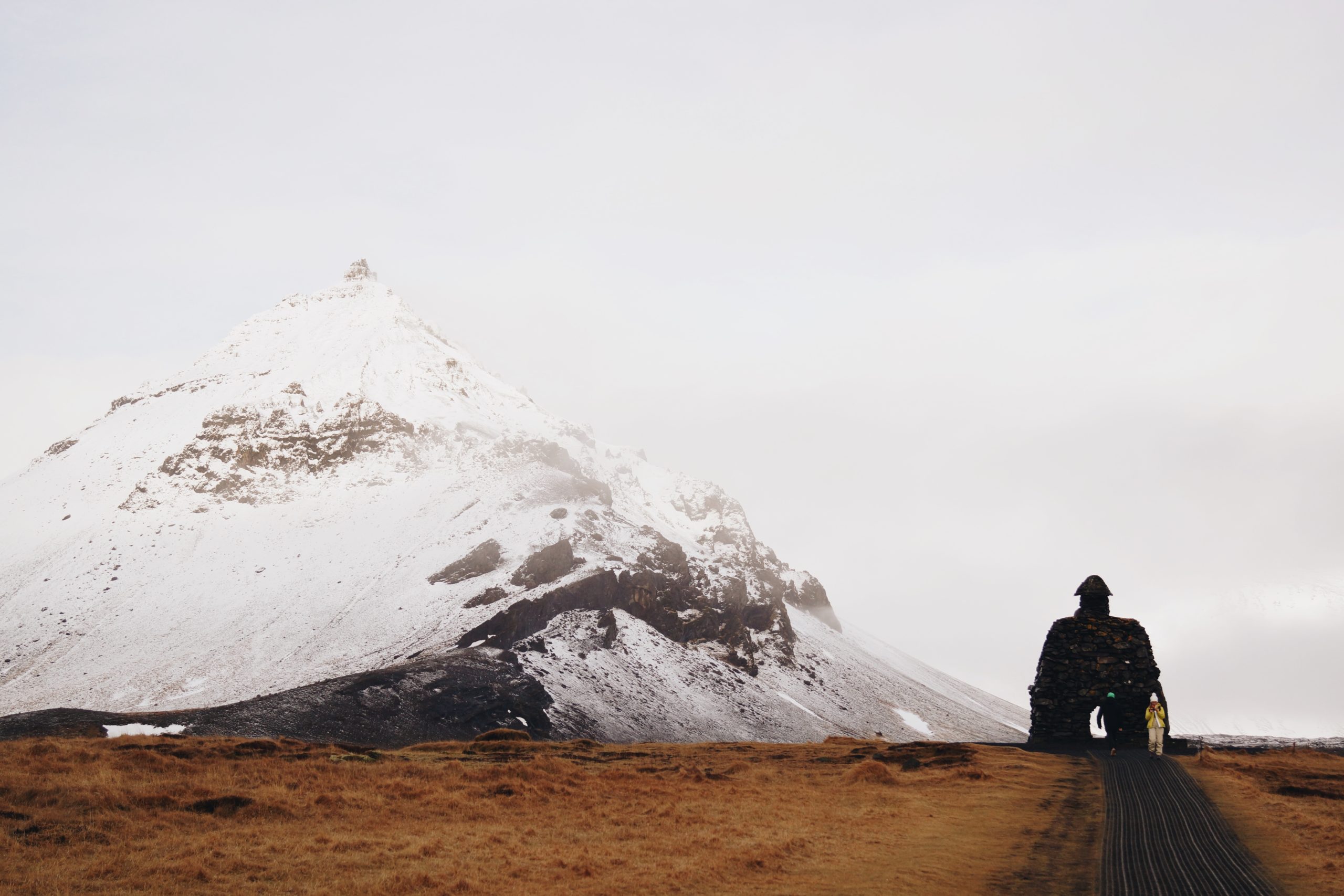
2. Hellnar in Snæfellsnes
The peninsula above Reykjavik is known as Snæfellsnes. A place that enchanted Jules Verne and featured in many historical Saga tales, Snæfellsnes became an EarthCheck community in 2008.
Truthfully you could travel the whole of the peninsula, and find thousands of good aurora spots. This is not a heavily populated zone, and during the day it is a phenomenal sightseeing location.
But we’re spilling the details on our favorite spots, so Hellnar has to make the cut! An ancient fishing village for many generations, Hellnar is perched on the tip of the peninsula overlooking the curved basalt coastline and the thundering sea.
People come from miles around to seal and whale watch, enjoy the varied geology of the area and view the countless natural landmarks in peace. You can travel quietly here, and enjoy the high-quality darkness of this northerly locale.
When in Hellnar, one can nearly imagine what it might have been like in centuries past- a bustling destination under a slumbering volcano.
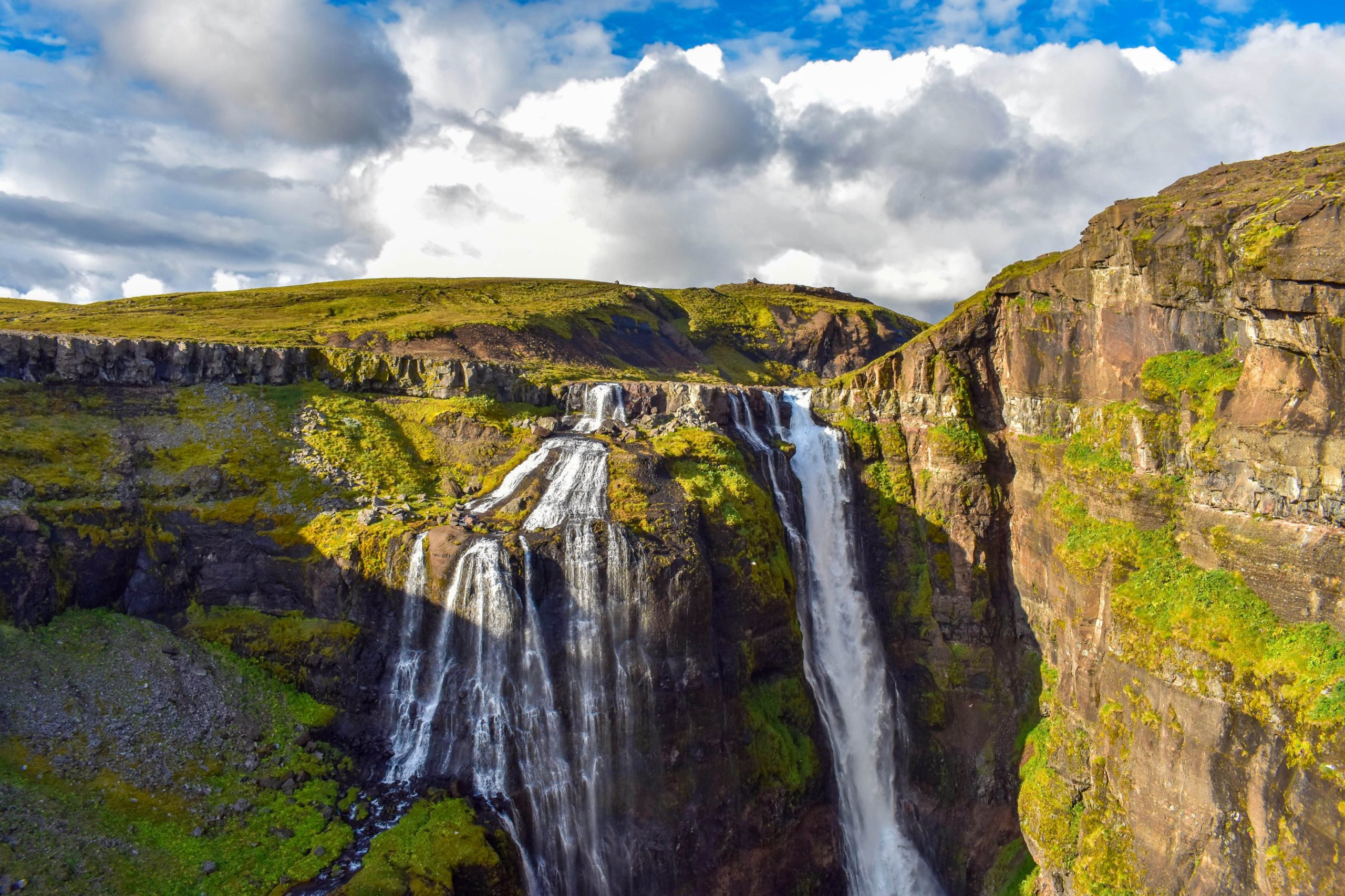
3. Hvalfjörður
Just outside of Reykjavik lies a hidden treasure off the main road. Hvalfjörður is the name of the fjord that lies between Mosfellsbær and Akranes. A short trip from the capital city, Hvalfjörður is home to many small waterfalls and hiking paths.
The popular trek to Glymur starts here, and many coastal hikes as well. The fjord itself is 30 kilometers long and there is not a stitch of it that does not house some kind of tiny wonder. Often passed over for more notable climes, this is a calm and beautiful place to aurora watch, with multiple marked observation points that are safe to park in.
Great for some daytime and evening hiking while you wait, the textured vistas and low traffic certainly make Hvalfjörður feel like the best place to see northern lights in Iceland.
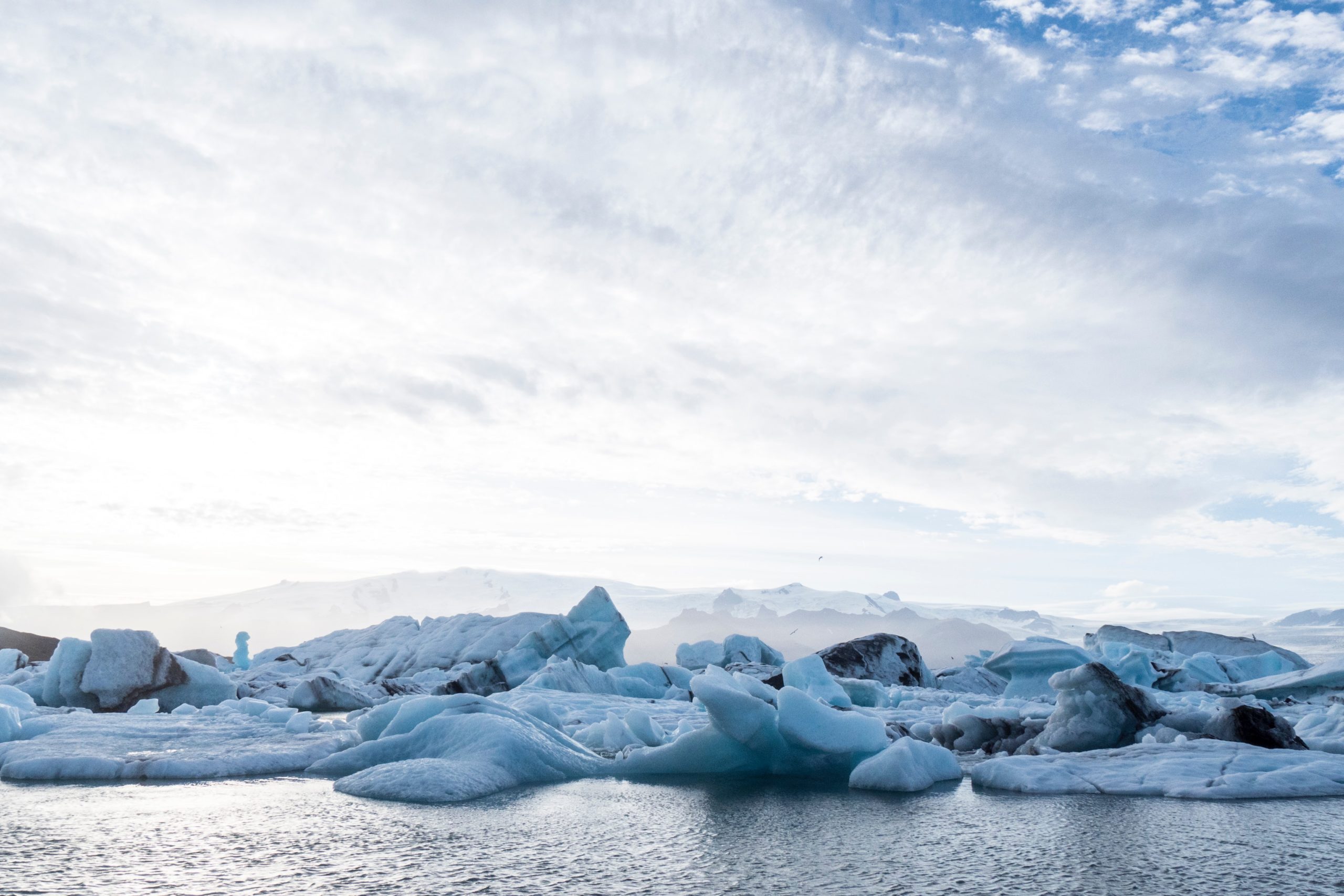
4. Jökulsárlon and Fjallsárlón
You have likely already seen Jökulsárlon on lists like these, and it is admittedly hard not to include it. One of the most dramatic glacial lagoons on the island, Jökulsárlon feeds out to sea across a black sand beach littered with giant chunks of ice.
Watching the huge pieces of ice swirl in the surf as if weightless, is a close competitor for the northern lights. But what about nearby Fjallsárlón? Only about 10 kilometers west of well known Jökulsárlon, lies this smaller more intimate lagoon.
Spectacular during the day, at night the lagoons can provide gorgeous reflection photos for aurora hunters and stargazers alike. Time spent next to these otherworldly spaces is special and fleeting.
They are truly impermanent and no repeat visit to them will ever feel the same. All the better reason to hurry- both the lights and the ice do not keep.
Tip: When visiting these spaces, be extra careful around the water and the ice. It is tempting to hurry forth and touch, but the calving of the glacier is unpredictable and can create impressive waves. The ice left on the beach is easily moved by the ocean, and just like the lagoons, can be dangerous up close. (What looks light in the sea, may feel rather heavy when dropped on your feet!)
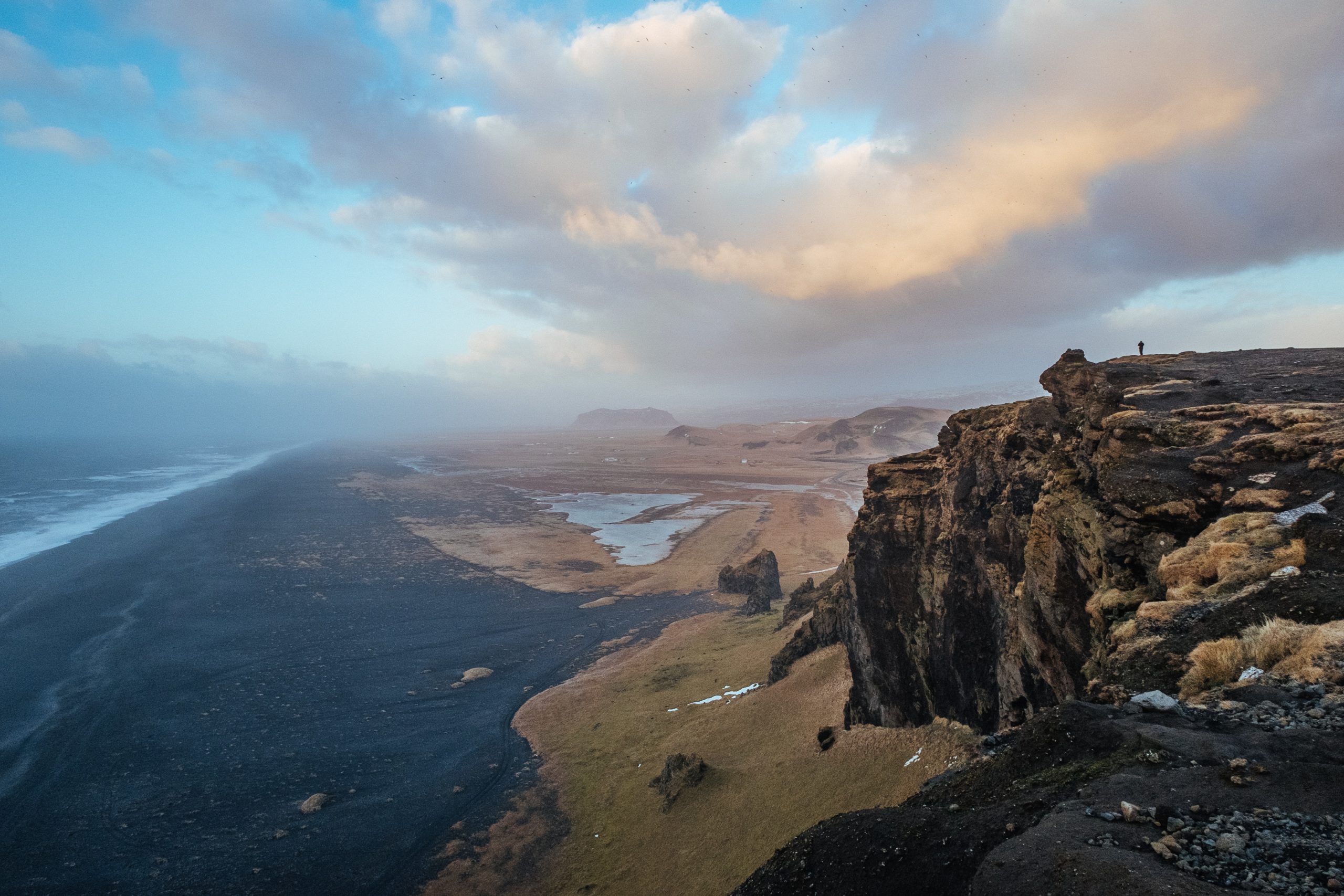
5. Dyrhólaey
Near the coastal village of Vík, there’s a promontory called Dyrhólaey. Named for the arched holes in the rock- or “door holes”, this is another ever-changing gem of the island, not to mention the southernmost point of the mainland! Featuring multiple paths, Dyrhólaey is a paradise of vistas.
There are many famous shots to be had here, and hardly anything to get in the way of them. An easy jaunt from the nearby village, Vík is a great refueling stop for explorers of this area. The south coast is punctuated by black sand beaches, huge basalt sea caves, and towering cliff waterfalls.
There are even northern light igloos that one can hide away in, which makes the south coast in general a great choice for the best place to see northern lights in Iceland.
Tip: Mind the pathways and signs when visiting this area. Dyrhólaey is changing, and pieces of the landmass are sometimes lost to the sea. Places that are roped off are roped off for a reason.
Check any signage you see before you hike out, as rangers in the area often update it due to shifts in the conditions of the land.
The ocean around this area is fierce and has claimed many lives. When visiting the shoreline, keep your distance from the waves- this beach is known for “sneaker waves” and unforgiving currents.
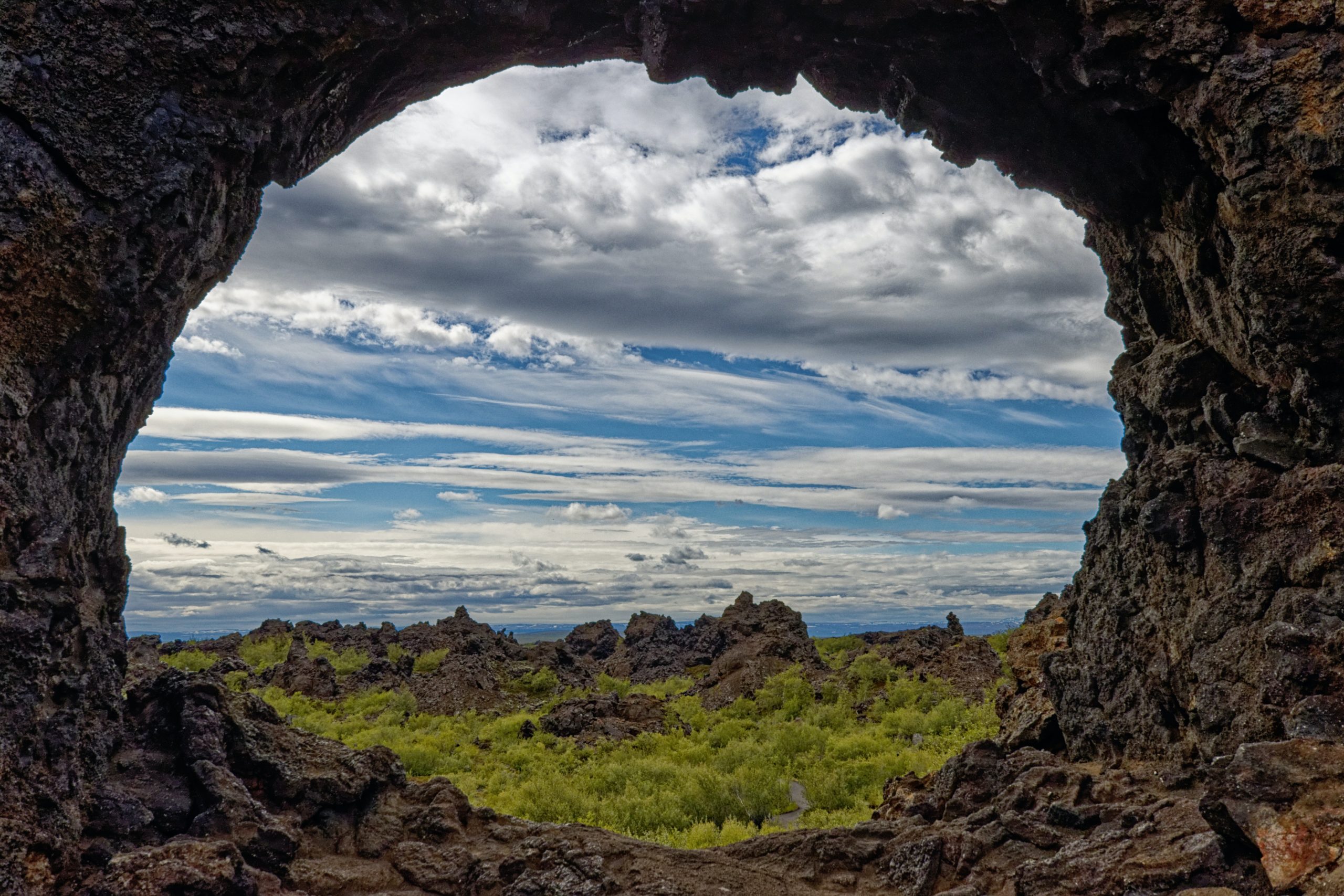
6. Dimmuborgir
In the north of Iceland near Mývatn, lie the dark castles. Otherwise known as Dimmuborgir, this strange lava field has captured the eye of many, from Norwegian metal band Dimmu Borgir, to the wildlings of Game of Thrones.
Characterized by the unusual rock stacks and tunnel formations, Dimmuborgir is a place of many stories and beliefs. But, regardless of what you believe, it is a shoe-in for best place to see northern lights in Iceland.
Being located in the picturesque Mývatn region, the dark cities overlook miles of great lakeside hiking and some of the north’s best geothermal bathing. For amateur and expert photographers alike, the craggy peaks of the lava and the still waters of Mývatn make incredible photos against the bright colors of the auroras.
Between the breathtaking natural wonders and the nearby amenities, it’s hard to find a better spot!
Tip: Visit this place during the daytime to familiarize yourself with the terrain. Mývatn may not be hugely difficult hiking, but these rocky areas can be challenging to navigate for the first time in the dark. Double up on your protection by bringing a headlamp or torch- extra points if it’s a red light for night vision preservation!
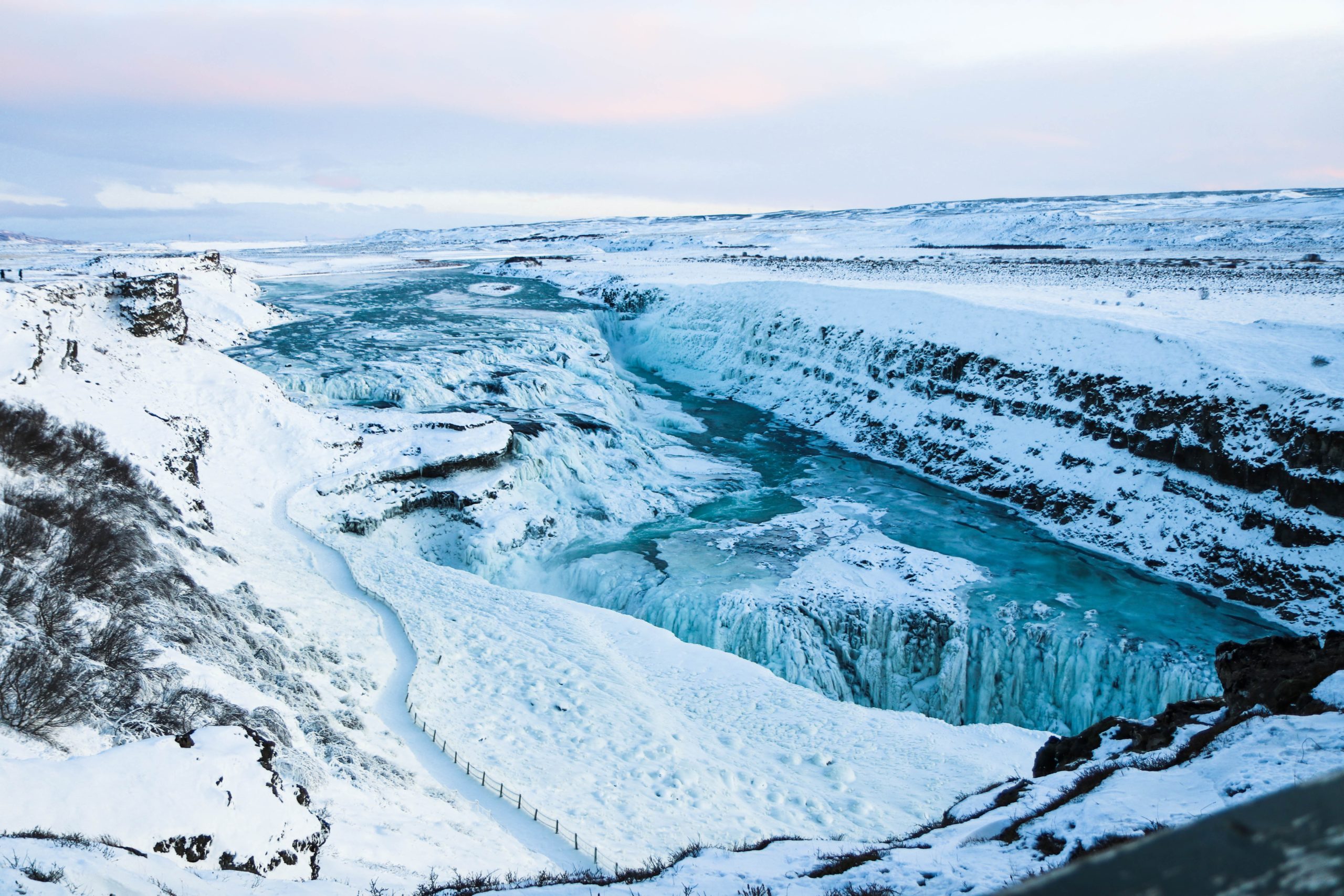
7. Gullfoss
Imagine reclining on a bench watching the northern lights, while a waterfall rumbles nearby. Doesn’t get any more peaceful than that! On our hunt for the best place to see northern lights in Iceland, we had to include a waterfall. Iceland is simply riddled with these gifts of nature, and Gullfoss is a big one.
Named for its golden illuminated appearance in the daytime, what is even more spectacular is the light that hits it in the nighttime. About 1 hour and 45 minutes from Reykjavik, Gullfoss is a protected area that hosts observation points, walking paths, and a parking lot with a cafe.
It’s rare to find a good aurora spot with a safe place to park your car, so spots like these should not be overlooked. The golden circle region is a great daytrip, and the roads are well maintained in the winter months.
Tip: If you plan on visiting the cafe or shop on your trip, make sure to check ahead and see what the hours are. These things can vary depending on the season, so it’s better to go in with no surprises. (Or at least one less- the lights are a big enough surprise on their own.)
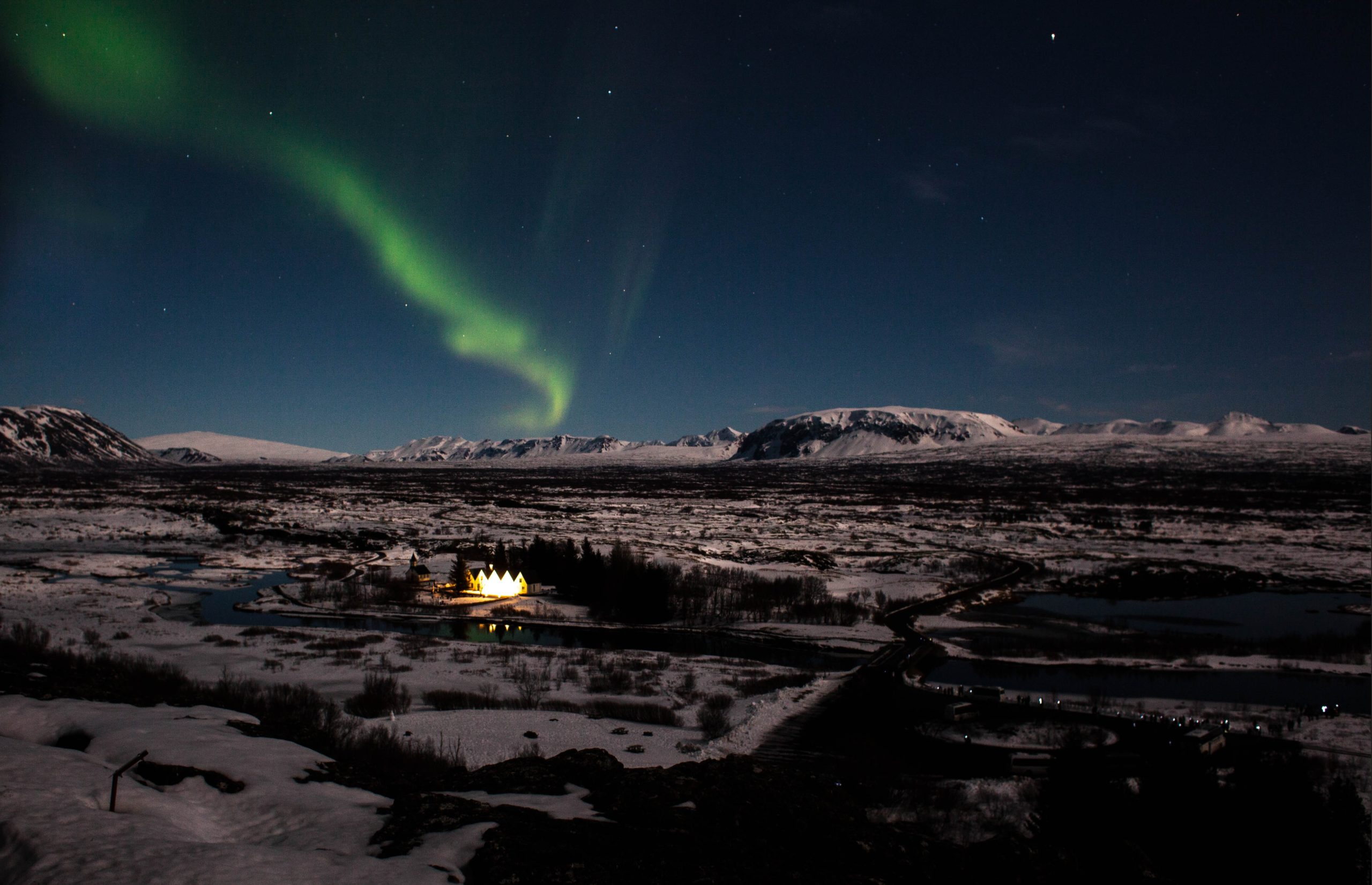
8. Þingvellir National Park
Only about 35 minutes from the capital, Þingvellir or Thingvellir should be on the top of your list for best place to see northern lights in Iceland- no matter where you’re staying. Once upon a time, Thingvellir was the most important gathering point for Icelanders, and it isn’t hard to see why.
Home to a massive lake, miles of hiking, and incredible views- Thingvellir is a place of activity. It’s also one of the places where you can see the continental rift! But as far as lights go, it’s a veritable playground.
When you’re out aurora hunting, you have to consider logistics. Things like places to park, places to get a snack, bathrooms, proximity to lodging, access to darkness, and so on. Most places will only have a few of these, but Thingvellir hits them all.
Being a national park, it’s designed to accommodate vehicles and wanderers. There are loads of paths to travel, established hiking routes, and plenty of parking lots and observation points to safely stow a vehicle.
This is a big win, because Iceland is full of narrow roads with few places to pull over for a show. Thingvellir is also aware of us aurora hunters, and so there are occasionally places to grab a coffee or a bathroom break along the way.
(Depending on how late you’re out, of course. Double check this before you go if it’s your destination.) You’re also in a great spot when you’re here. Thingvellir is just a half-hour north of Reykjavik, and rests at the entrance to the Golden Circle region. (Or exit, if you came the other way!)
And even though you’re close to town, you will find that Thingvellir is home to some surprisingly good darkness. Because of its inland location and its historical importance as a gathering point, it’s well-positioned on the edge of the highlands.
And there’s tons to do! The only mistake you can make by aurora hunting here is to skip visiting in the daytime. In the autumn, Thingvellir is a rainbow of foliage.
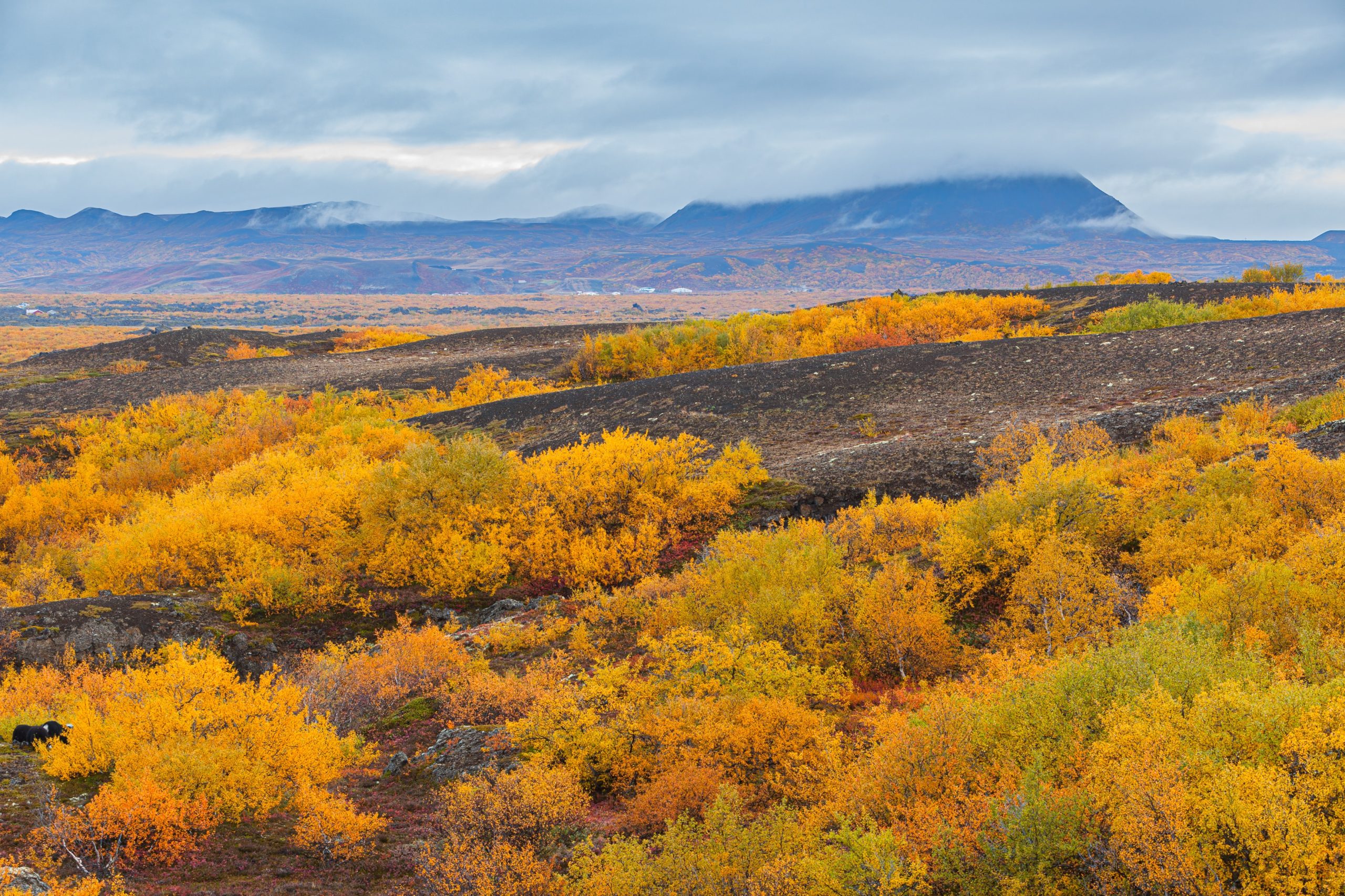
9. Ásbyrgi
This is a rarer stop in the north of Iceland. Located on the Diamond Circle, Ásbyrgi is a horseshoe-shaped canyon that some believe was made by a glacier.. But really we know it is where Sleipnir touched hoof to Earth.
The views to be had here are unique, as the steep walls of the canyon protect a vast forest within their embrace. Because of this “Shelter of the Gods”, Ásbyrgi is an incredible place to visit in the autumn months to catch the color changing of the leaves, and the crystal pond among them.
There is a campsite here, and multiple trails to enjoy all the different views that the huge canyon has to offer. But be careful while you’re here- to us this may be the best place to see northern lights in Iceland, but to some it is the elven capital. Tread lightly!
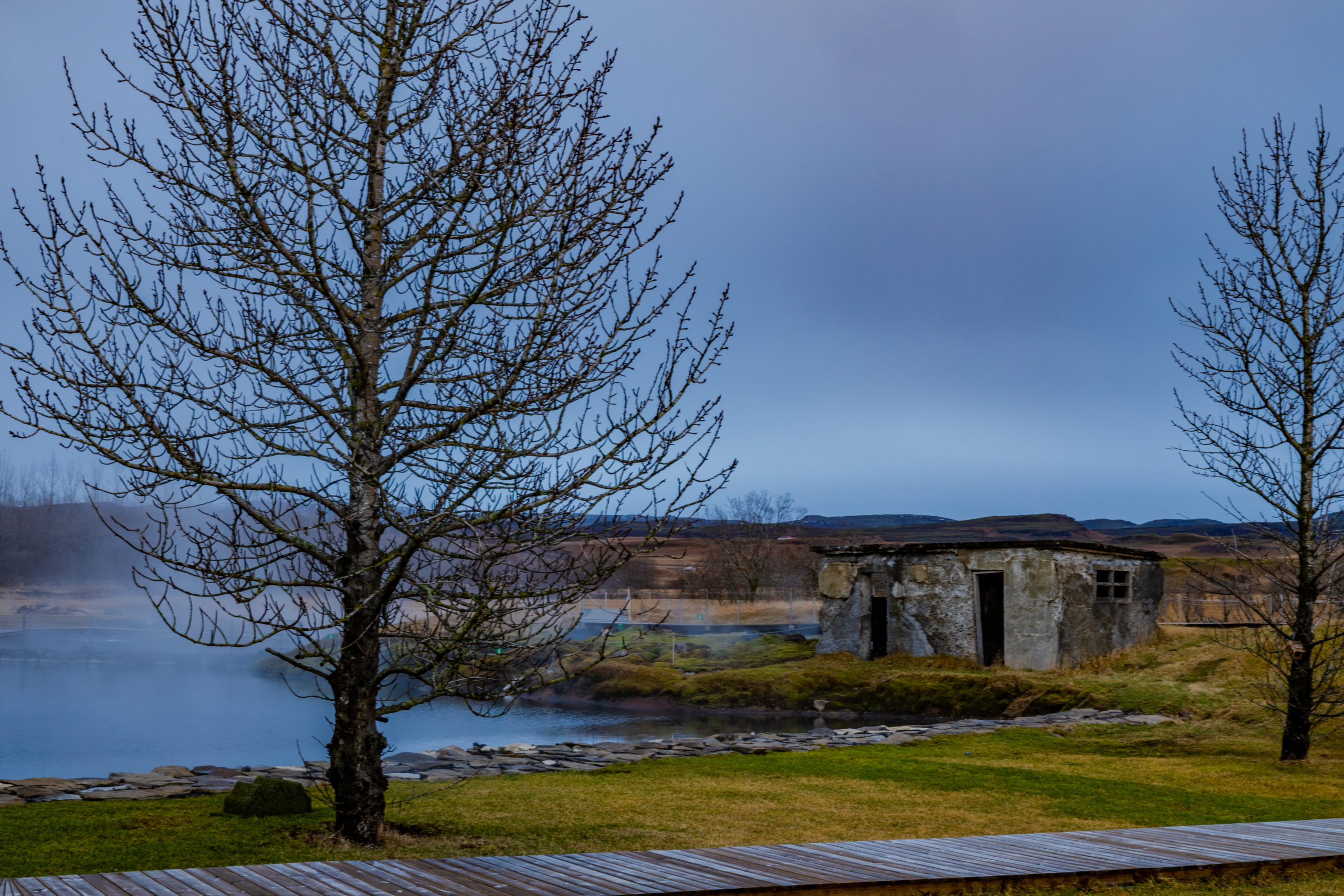
10. Gamla Laugin: The Secret Lagoon near Flúðir
The truth about the best place to see northern lights in Iceland, is that it will change with the weather, and with your expectations. Maybe you have a certain photo you want to get, or a certain thing that you want to see. Maybe you want to stay in a specific region, or are looking for cozy places to unwind while you you look.
Places like the Secret Lagoon near Flúðir, perhaps. We are pretty big fans of watching the lights from warm places, and this is one of the warmest. If your plans and the weather both allow it- watching the aurora from a natural hot spring is an incredible experience.
Particularly one as beloved as the Secret Lagoon. One of Iceland’s oldest “swimming pools”, this is the place where many southern Icelanders first learned to swim.
And within 24 hours, it has replaced its own water as it continuously flows. One of the most authentic bathing experiences there is, coupled with one of the most authentic aurora watching spots we know.
Tip: Check the website before you go to see what the conditions are for that day. Depending on traffic, you may need to book in advance. (The lagoon is big, but it is always better to plan ahead if you can.) The hours of the lagoon may change, so double-check the schedule to see how late they’ll be open when you visit.

